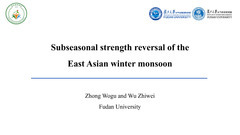报告详情
Subseasonal strength reversal of the East Asian winter monsoon
编号:3320
访问权限:私有
更新:2023-05-03 21:41:31
浏览:995次
口头报告
摘要
As one of the most significant circulation systems over the Northern Hemisphere in the cold season, the East Asian winter monsoon (EAWM) has been broadly investigated from the seasonal-mean perspective, while subseasonal variations in the EAWM still remain ambiguous. Based on Season-reliant Empirical Orthogonal Function (S-EOF) analysis, this study shows that the subseasonal strength reversal of the EAWM (SR-EAWM), featuring a weaker (or stronger) EAWM in early winter (December) and a stronger (or weaker) EAWM in late winter (January-February), is a distinct leading mode of the month-to-month variation of the EAWM. The weak-to-strong SR-EAWM is characterized by an anomalous low over Eurasia and a weakened East Asian major trough (EAT) in early winter, with an intensified Siberian High and a deepened EAT in late winter. The SR-EAWM is preceded by surface air temperature anomalies over Davis Strait (DST) and those over central-eastern North America (CENAT) in September-October. The DST mainly influences the SR-EAWM in early winter through a "sea ice bridge" of the November Baffin Bay sea ice concentration anomaly (BBSIC). The BBSIC could intensify the DST in December by altering surface heat flux, thus exciting a downstream atmospheric response and modulating the strength of the EAT in early winter. The CENAT affects the SR-EAWM in late winter by inducing an "ocean bridge" of the western North Atlantic sea surface temperature anomaly (WNASST). The WNASST can persist into late winter and then significantly affects the SR-EAWM by regulating Eurasian circulation anomalies and the downstream EAT. The bridge roles of the BBSIC and WNASST can be further verified by a linear baroclinic model. Finally, two physical-empirical models are established using the DST/BBSIC and the CENAT indices, respectively. Both exhibit promising prediction skills. The results highlight that the DST, BBSIC, and CENAT are crucial predictability sources for the SR-EAWM.
关键词
East Asian winter monsoon;subseasonal variation;surface air temperature;seasonal prediction
报告人

钟沃谷
复旦大学稿件作者
全部评论
重要日期
-
会议日期
05月05日
2023
至05月08日
2023
-
03月31日 2023
初稿截稿日期
-
05月25日 2023
注册截止日期
主办单位
青年地学论坛理事会
中国科学院青年创新促进会地学分会
中国科学院青年创新促进会地学分会
承办单位
武汉大学
中国科学院精密测量科学与技术创新研究院
中国地质大学(武汉)
中国科学院精密测量科学与技术创新研究院
中国地质大学(武汉)



发表评论